Wine and Whiskey Tasting in California’s Paso Robles, 2018
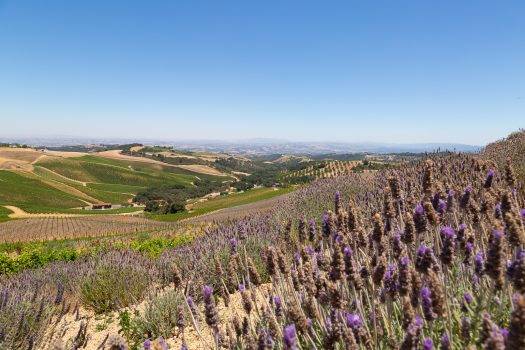
Paso Robles, in the northern part of San Luis Obispo County, has a storied past: a history of habitation by the Salinan Indians that we can trace back thousands of years, a change of hands to Mexican ownership (before and after the Mexican-American War ,when the U.S. annexed California) and an eventual purchase from a Mexican military man by gold-rich ’49ers, a vigilante and a rancher, and the cattleman uncle of Jesse James.
Since then, the Paso area has become a popular wine region in the Central Coast of California. Historically, it’s been known as the place to find bruisers, i.e. big bold wines not afraid of high alcohol content. That’s what I’ve tasted in past trips there (excluding Tablas Creek, of course). Reading a Wine Spectator from spring 2018, one would think that was still the M.O. for Paso wines.
And to be sure, there are many wonderful people who love big wines! Sometimes, I am that type of wonderful person. But what I experienced on my most recent, mid-June trip to Paso though was more akin to marshal arts fighters (to keep the fighting style metaphor going), wines that were lithe and precise.
all photography by Leila Seppa
Thacher Winery
Paso Robles and the surrounding area where winemaker Sherman Thacher (previously a celebrated brewmaster at Las Gatos Brewing Co. for 16 years) gets his non-estate fruit gets really warm. It’s near the ocean, so it has surprisingly cool nights that make it a suitable place for growing wine grapes, but it’s mostly the heat that’s responsible for the big wines they are known for.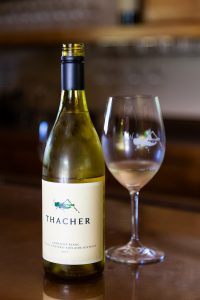
Sherman is doing something different. He is very talented and manages to showcase the acidity in his wines, complementing the fruit and adding layers of complexity. The Thacher 2017 Cinsault Rose clocks in at just 10.5% alcohol and has the most unusual barnyard nose, with fresh, light fruit on the palate. It’s $28. They also make Zinfandel, Rhône blends, and a delicious Blanc de Blanc sparkling. I enjoyed the wines across the board.
After tasting at the bar, we had fun tasting in the barrel room, then we all jumped in the Kubota tractor to finish the day with a beautiful view of their vineyards, narrowly avoiding torpedoing ground squirrels along the way. It’s worth noting that Thacher Winery used to be a horse ranch. The letters KR, for Kentucky Ranch, still crown the barn they now use for dinners and dancing and barn owl watching. At the moment, at least two owls call it home. If you haven’t ever seen one, look up barn owls. They are super cool and strange and we got to see them LIVE.
Make an appointment and go visit the people at Thacher; highly recommended. You can also stay at their lovely guest house.
Breçon Estate
Just a couple minutes down Vineyard Dr. you will find yourself at Breçon Estate, an entirely different universe from Thacher, equally compelling and stylistically opposite in design. Welsh winemaker, Damian Grindley, was kind enough to take us through a tasting on the comfy couch outside.

Breçon has an LA-chic atmosphere, designed by celebrated architects, with country accents such as tables made from old barrel wood. It’s a gorgeous, spirit-refreshing, luxurious place to bring a picnic to pair with Breçon wines. The back window of their tasting bar opens during summer for a complete outdoor experience, if that’s what you’re looking for. Otherwise you can head inside for a classy and comfortable indoor tasting.
Damian likes to play with unusual blends, like his smooth and spicy Zinfandel and Tannat blend, 60% Zinfandel, 40% Tannat. It’s an elegant wine, despite the strong presence of Tannat, a varietal normally known for its heft. I was also a fan of the Viognier and especially the Grenache. These were all light-on-their-feet in style, in no way “typical” Paso-style wines.
And in wonderful contrast to the upscale feel of the property, Damian and his wife Amanda were warm, friendly and without pretense.
Giornata
Giornata has been making kung fu wines since its inception. They produce all Italian varietals, all grown in the Paso area. The name of the brand means roughly, ‘the measurement of a good day’s work’ and the couple behind the brand, Brian and Stephanie Terrizzi, have had many a good day’s work together.
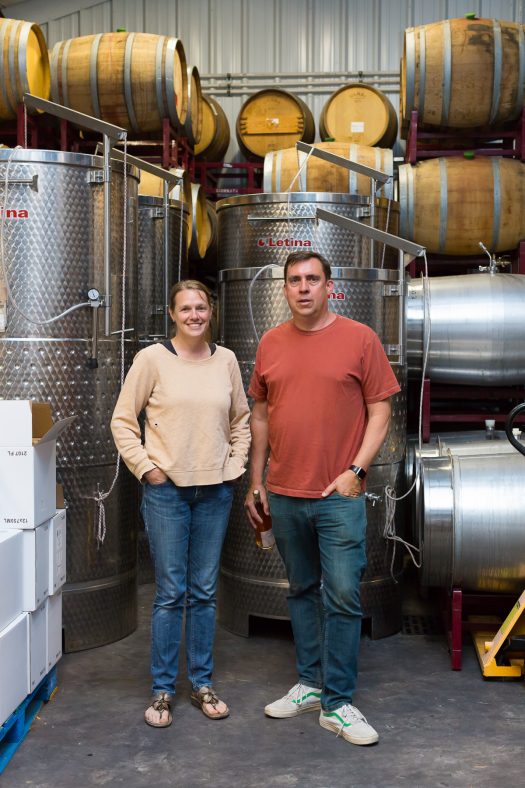
Stephanie is a vineyard manager and is the go-to person in Paso for grower advice, whether she feels like talking about it at lunch or not. Brian is a most unusual winemaker who doesn’t step foot in the vineyards he gets his fruit from, because he trusts his wife. This combination has been producing unique, world class Giornata wines for many years now.
Their wines are delicious and relatively inexpensive. The Giornata 2017 Il Camp Blanco is perhaps the best $20 white I’ve ever tasted, and we tasted it with barely a chill on it, always a sign that the white wine really is good. I also loved the 2016 Ramato Cinque ($35), a Pinot Grigio fermented on the skins which produces an orangish-pinkish color, and the 2015 Nebbiolo, Luna Matta Vineyard ($45). Nebbiolo is the grape that goes into the (well-deservedly) famous Barolo and Barbaresco wines.
Wife in the vineyards, husband in the cellar—their perfect pairing frees up time for Brian to do other projects such as their new store and kitchen, Etto Pastificio. A fresh pasta and specialty food shop currently filling a need in the area for organic produce, imported food items, fresh sauce and pasta that they sell refrigerated fresh and/or dried.
Brian Benson Cellars
Brian Benson is a Paso Robles legacy winemaker. When we met, he said his family had a habit of getting into the wine business and then divesting as soon as the next generation joined in. He grew up playing and learning on his grandparents’ West Paso vineyard, and then at his father’s Paso winery, and now he alone keeps the legacy alive.
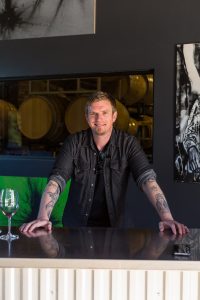
Brian’s winery facility is in the rapidly expanding Tin City, along with Giornata, Zevo, Field Recordings, Desparada, and others. His style is more akin to the traditionally celebrated bold Paso wines; Zinfandel and Rhône varietals well made for the discerning wine drinker looking for knockout flavor.
His labels are his personal art. Using one of the most fascinating creation processes I’ve come across, he creates what might be called a “bullet splash.” You see, he also learned to shoot a shotgun in his grandparents’ vineyard. To achieve the bullet splash, he sets up a painted board with carefully placed Dixie cups filled with paint (black, yellow, white) affixed to it. He shoots the cups from long range, with a type of bullet that expands on contact with the cups (or whatnot) and scatters the paint across the board for an exhilarating effect.
The resulting labels are artistic expressions of massive force—not unlike the Brian Benson Cellars wines. Three versions of these images are currently available on his 2014 Caliza Vineyard Grenache, Syrah, and Syrah Mourvedre blend.
Cordant | Nelle
We drove into a warehouse-y sort of strip mall and found Tyler waiting for us at his doorstep. “Come on in!” he said. Winemaker Tyler Russell is so comfortable in his own skin, he puts everyone at ease. His winery and tasting room are laid back, with character and comfort. It’s off the beaten path, for sure, and that’s the way he likes it.
The first unusual thing to note is that he has two labels, both are his and his business partner David Taylor’s, separated to distinguish between varietals and blends. Cordant was initially envisioned as a Pinot Noir label, but grew to include certain Rhônes; however, its future appears to offer an all-Pinot (and maybe some Chardonnay) line up. The Nelle label is about Rhône blends of traditional and unusual stripes.
For our main tasting, Tyler took us into the barrel room where a beautiful table was set with personalized tasting notes and wine already in the glasses. Behind the head of the table sat a turntable and record collection between a set of stylish speakers, oh, and on wheels. He likes to be able to take it with him when necessary. This could seem like an affectation but was actually awesome.
He makes really good wine! Blends and co-ferments of unique character and careful attention to detail is his M.O. He, like most winemakers, respects and cherishes his vineyard sites and his mission to make great wine. His complete dedication to originality results in uncommon tasting wines that are as good as they are singular.
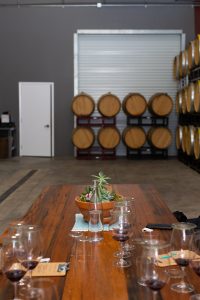 Some highlights:
Some highlights:
2015 Cordant Kessler Haak Vineyard Pinot Noir Santa Rita Hills — a beautiful expression of Pinot Noir with the rich dark fruit from that region at its core. 70% New French oak is smoothly integrated with floral notes. $50
2015 Nelle Maniacal Paso Robles — 50% Grenache, 35% Syrah and 15% Mourvedre from Killer Canyon in Westside Paso. Rich blueberry and cassis, lavender, smoked meats and lead. $38
2017 Nelle Pinwheel — a blend of 70% Grenache Blanc, 15% Rousanne, 15% Viognier. 115 cases produced, showing concentrated flavors with soft tropical fruits and perfect acid balance. $34
Tablas Creek
And the Mack Daddy of them all, at least in regards to making lighter-bodied, higher acid wines in Paso Robles, is the pioneering label Tablas Creek. The history goes that Vineyard Brands importer and Tablas Creek patriarch Michael Haas sought after southern Rhône-born Chateau de Beaucastel wines with such intensity that after making a trip there in the mid-1960s to ask for an allocation, the Perrin family told him to come back the following year if he was serious. A year later, he returned, and after years of a partnership in the U.S. market Tablas Creek became a gleam in their mutual eyes.
They formed a vision of a new label, deduced that Paso Robles was the correct climate for growing their Rhône varietals in North America and set vine clippings and rootstock in motion towards their new California home. They named the property Tablas Creek after a small river running through it. Since the 1997 debut Tablas Creek vintage, they have been the area’s (Drunken?) Masters.
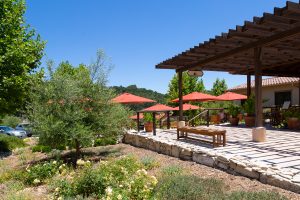
On our tour of the vineyards, under an unusually hot sun, we learned that they are currently having a mountain lion problem. The cats are attacking their grazing sheep, population now less than 100 sheep. They practice Biodynamic farming and need 300 sheep to effectively graze the land, so they are working on that. We then took a welcome cold air bath in the tank and barrel room.
I loved the 2017 Tablas Creek Picpoul Blanc ($30), with its bright fresh apple, crushed stone, neutral oak and stainless fermentation, as well as the 2017 Tablas Creek Dianthus Rosé, made in the traditional Southern Rhône style, and the 2017 Counoise, tasted from tank. Perhaps because they are making wine in California, the acidity is less piercing across the board in comparison to their French cousins, which is nice way to broaden the consumer base and introduce these wines to folks of different preferences.
Krobar Craft Distillery
Did I mention how much I like whiskey? For a change of pace after lunch at the awesome Barton’s Kitchen Window, we went to a tiny, old-timey feeling, authentically hip bar at Krobar Craft Distillery. The local bar manager of Hatch, another delicious and super popular restaurant in downtown Paso, came in soon after us to stock up for some cocktails she was creating.
Up a spiral staircase, we toured the Krobar lab filled with distillation equipment and beautiful rows of jarred botanicals that go into their gin, with a view of the barrel room below.
And then we got down to the booze. Back at the bar, we tasted through their latest offerings and I discovered their insanely good Rye and Rye Cask Strength. They were both so easygoing, with just the right hint of sweetness on the finish, heavy on spicy rye, light on corn.
They also make excellent Gin and Bourbon and their very own Bangin’ Bitters. And yes, we left with a bottle of the Rye.
Many, many thanks to Brian and Stephanie Terrizzi for the hospitality and insider tips. Some of the places we visited are by appointment only, so when you’re going to be tasting in Paso Robles, be sure to call ahead when necessary.
Happy gustatory exploration!




